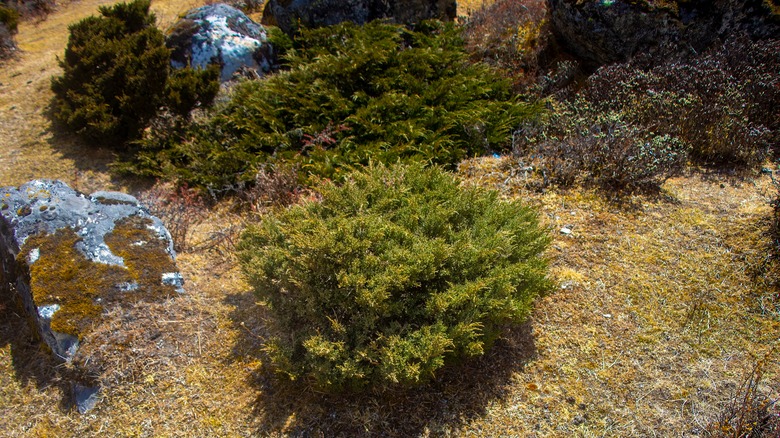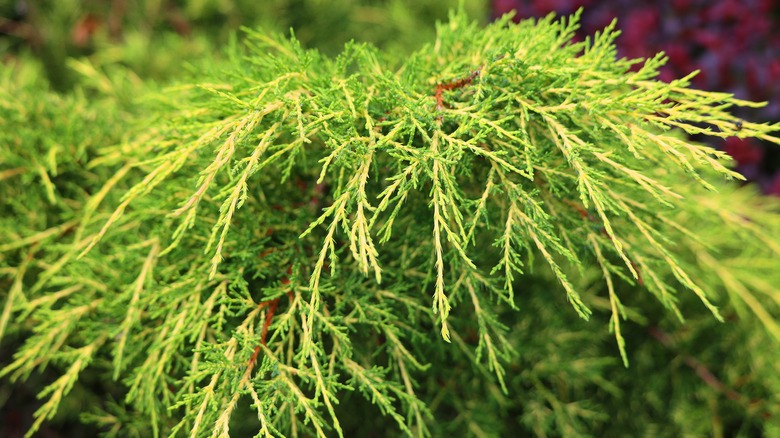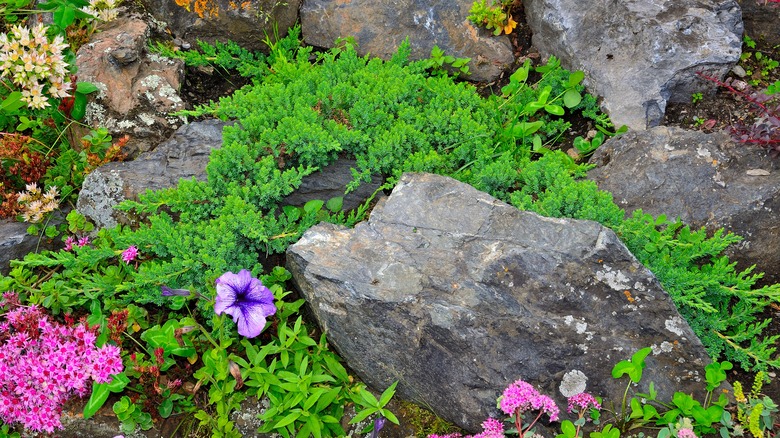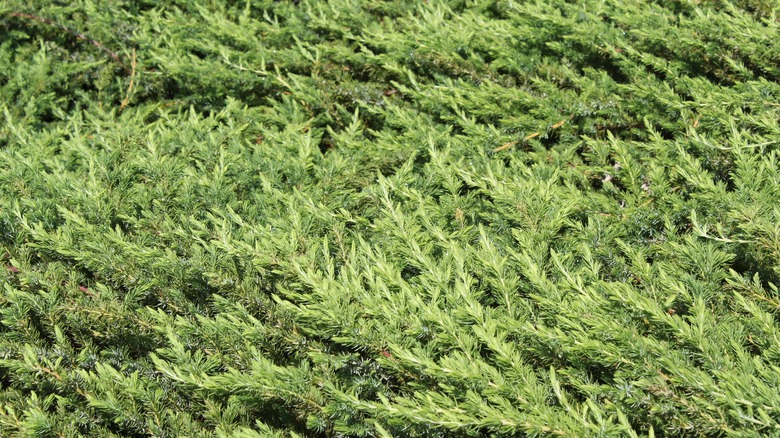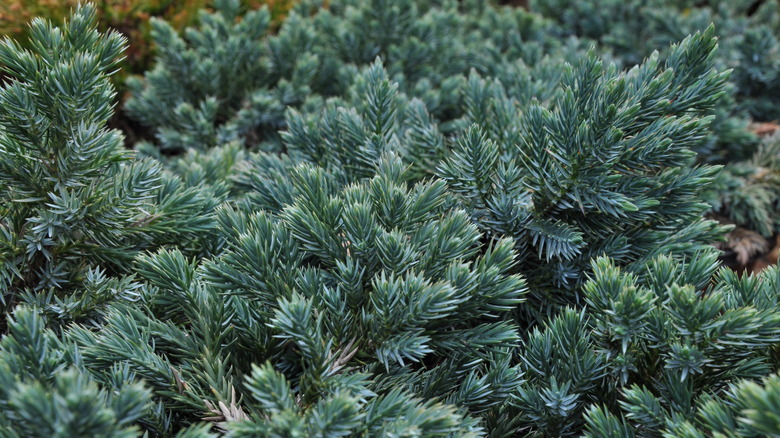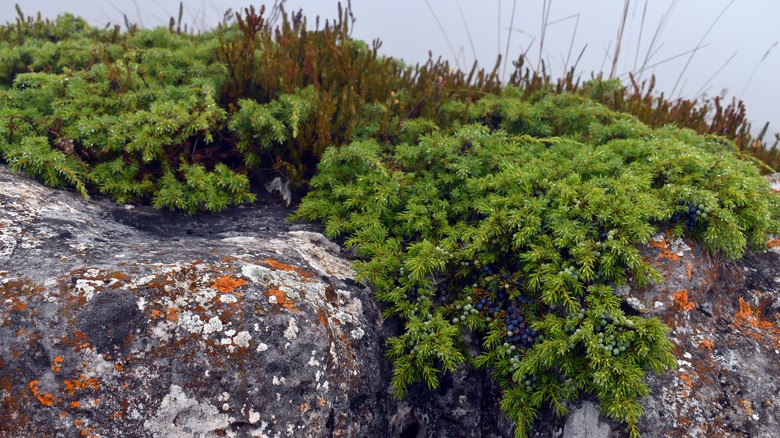Types Of Juniper Ground Cover Plants And How To Choose The Best One For Your Yard
Juniper is a broad genus that includes everything from large trees up to 30 feet tall to ground-hugging shrubs that spread wide but never get higher than 18 inches. While species like the fast-growing Taylor juniper tree makes a great privacy hedge, various low-growing junipers are a great option for gardeners who need a long-lasting, low-maintenance ground cover.
From creeping juniper to common juniper, there are lots of options that adapt to a wide range of climates and conditions. So, gardeners just about everywhere can plant these evergreen ground covers for stunning color all year round. Whether you need a plant that boasts great drought and heat tolerance or a ground cover that can handle salt, there's a juniper species for you. Just make sure you have a dry site to plant it as none of these ground cover junipers like wet soil.
It's also important to know that ground cover junipers tend to grow slowly. This is great for the long term, as the plants will require minimal pruning or maintenance to keep them in check. However, if you're looking for a quick way to fill in a larger area, you will need to get multiple plugs of your preferred juniper and plant them at the closest recommended spacing listed on the package. Still, if you're willing to give them time, low-growing junipers are some of the hardiest ground covers that require almost no ongoing maintenance once established.
Creeping juniper thrives almost anywhere
Native throughout much of the United States and Canada, creeping juniper (Juniperus horizontalis) spreads via lengthy, drooping branches that hug the ground. At maturity, a single plant can cover up to 10 feet of ground while only growing about 18 inches in height. Some cultivars max out at just 6 inches tall.
Creeping juniper can thrive in a wide variety of climates. It's hardy in zones 3 through 9 and boasts good heat and drought tolerance. It also tolerates salt, air pollutants, and poor soil. So just about every homeowner in North America can likely plant creeping juniper successfully. One of the only things it won't adapt well to is wet soil with poor drainage. While this evergreen ground cover is hardy and adaptable to almost any conditions, it can become vulnerable to disease and pests if it's under stress — especially if planted in shade or in soil with poor drainage.
Choose creeping juniper if you have a dry, sunny yard and you're looking for drought tolerant ground covers you can easily grow. It's a great pick for those challenging spots near roads or along coasts where the salt or air pollution make it inhospitable to most plants. Don't choose creeping juniper if the area you're planting it in is shady or has wet soil. You should also avoid overhead watering and make sure the plant has enough air circulation to dry out quickly after rain or watering.
Japanese garden juniper stays green all year and resists disease
Japanese garden juniper (Juniperus procumbens) is another ground-hugging species in the juniper family. The intertwining branches form a dense mat of evergreen needles that will typically spread up to 15 feet wide and grow no taller than about 2 feet. Some cultivars are even shorter. For example, dwarf Japanese garden juniper (Juniperus procumbens 'Nana') usually maxes out at 6 to 12 inches in height, while offering the same 15-foot spread. Unlike creeping juniper, Japanese garden juniper typically stays green through winter rather than taking on a purplish hue. It also doesn't have many serious pest or disease problems.
Like creeping juniper, it prefers full sun and well-drained soil. It grows in USDA hardiness zones 4 through 9 and also tolerates drought, heat, and other adverse conditions well. However, Japanese garden juniper and its cultivars are slow growers that can take as long as 10 years to spread 10 feet. You'll get quicker coverage by planting multiple plugs of Japanese garden juniper and allowing them to fill in the area. Choose Japanese garden juniper if you want something that looks similar to creeping juniper, but is a little less disease-prone and offers more consistent green color all year round.
Shore juniper is the most salt tolerant variety
As you might guess from the name, shore juniper (Juniperus conferta) is typically found growing along sea coasts. Unsurprisingly, shore juniper is one of the best options for gardeners who need a salt-tolerant ground cover for their yard. It will tolerate both saline soils and salt spray carried by coastal winds or along roads where de-icing salts are used. Shore juniper is also a popular choice for erosion control. It's long, hanging branches cascade beautifully over retaining walls and form a dense mat to cover a slope. Each individual plant will spread up to 8 feet wide while only getting about 18 inches tall.
While it prefers drier conditions just as much as other junipers, shore juniper is a little more tolerant of wet soils and part shade than its relatives. However, it's still best to plant it in the driest, sunniest part of your yard as it might become more susceptible to disease if exposed to wet conditions. It's also one of the least cold-tolerant junipers, thriving only in zones 6 through 9.
Choose shore juniper if you're covering a hot, dry area that's exposed to salty soil or air. Provided you're in a warm-enough climate, it will tolerate extreme heat, drought, and poor soil, all while remaining a lovely shade of blue-green all year round. Don't choose shore juniper if you live in a colder climate. While it might survive, it's likely to turn yellow during winter.
'Blue Star' juniper needs the least maintenance
'Blue Star' juniper (Juniperus squamata 'Blue star') is a dwarf cultivar of singleseed. The evergreen ground cover is a bit more shrub-like than other junipers, forming a dense mound that reaches about 3 feet tall and 4 feet wide at maturity. This makes it a great ground cover option for filling in the space along a walkway or garden bed. It's dense enough to provide solid, evergreen ground cover but it won't creep out into the walkway or climb over borders the way trailing junipers might.
'Blue Star' juniper is hardy in zones 4 through 8, placing it among the more cold tolerant junipers. However, it still prefers dry and sunny climates just like its relatives. With that said, it's not quite as heat tolerant as other juniper ground covers and definitely doesn't like wet soil.
Choose 'Blue Star' juniper if your top priority is finding a low-maintenance ground cover. In addition to being drought tolerant and adaptable to a wide variety of soil conditions, its compact growth habit means it needs little to no pruning to maintain a tidy, attractive shape. That means you can more or less ignore this plant once it's established. That said, avoid 'Blue Star' juniper if you need to cover a large area. You'll have better luck with one of the trailing species like creeping juniper or Japanese garden juniper that can spread over a much wider area.
Canadian juniper is best for cold or shady yards
Canadian juniper or ground juniper (Juniperus communis var. depressa) is a variety of common juniper, one of the most widespread juniper species with native varieties found throughout North America, Europe, and Asia. With a reputation for thriving in some of the harshest environments where little else survives, it's a great choice for gardeners who want a hardy ground cover that can handle neglect or adversity. It's hardy in zones 2 through 6, thrives in thin, rocky soils, tolerates wind, and is both cold-tolerant and drought-tolerant. It's also one of the only junipers that can tolerate anything from full sun to full shade.
In short, if you live in a cold, arid climate and have struggled to find a ground cover that can handle it, Canadian juniper is for you. It's also a great choice for homeowners in the warmer parts of its range that need a shade-tolerant evergreen ground cover. As long as you can keep it dry, it can survive even in deep shade where it gets no direct sunlight.
The slow-growing ground cover spreads up to 12 feet wide via trailing branches. While it can grow up to 6 feet tall, it rarely grows above 4 feet and can be pruned once a year to keep its height and shape in check. In the coldest parts of its range, it might turn a brownish-green in winter. Otherwise, it remains an attractive gray-green color year round.
